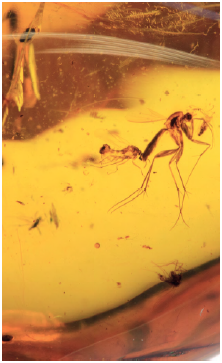Tentative Method for Determining the Age of Amber using DSC (TOPEM)
 Figure 1: Example of an inclusion in amber from the Baltic region (www.fossilien.de).
Figure 1: Example of an inclusion in amber from the Baltic region (www.fossilien.de).Fossilized resins originating from conifers are well known as “amber”. The frequent inclusion of plants and insects in amber is of interest for scientific studies and jewelry manufacture. Because amber is expensive, fake amber and amber imitations made from plastic or artificially aged tree resin are frequently found on the market. The determination of age is therefore a very important criterion for assessing whether an object is true amber or not.
Introduction
Differential scanning calorimetry has proven to be a simple technique for classifying amber and other resins according to age. The method uses the glass transition temperature (Tg) measured in the first heating run. Experiments showed that old fossilized resins exhibit a high glass transition temperature due to the slow crosslinking or curing reaction that takes place over millions of years and through the reduction in oil content.
The glass transition temperature of fresh tree resin occurs at about room temperature and that of 40-million-year-old amber at 150 °C. Experimentally, enthalpy relaxation and a postcuring reaction overlap and mask the glass transition in a conventional DSC measurement. The glass transition temperature can nevertheless be reproducibly determined using TOPEM®, a temperature-modulated DSC method.
Amber
Fossilized resins of conifers are wellknown as amber. The mineralogical name for the resins from the Baltic region is succinite. Amber is widely used for jewelry. The Amber Room in Saint Petersburg, Russia is famous. Before the plastics era, fossilized resins were used as basic materials for paints, as insulators in electrical applications, and in medicine.
Nowadays, inclusions of plants, insects, and creatures in amber are also of scientific interest (Figure 1) because they provide information about life and the environment millions of years ago. The well-preserved inclusions also have high esthetic value and are hence valuable for jewelry. This again inspires criminals to manufacture fakes: It is not always so easy to distinguish natural amber from fake amber, especially when the objects are made from aged copal.
Copal is subfossil tree resin that is in an intermediate stage of curing between a gummy resin and amber and is usually between several tens of years and several thousands of years old. Amber in the wider sense not only originates from the Baltic region but also is found...
Download the full text of this article below.
Summary
The shapes of the curves from DSC and TOPEM® measurements differ significantly and allow the samples to be classified according to their glass transition temperature. If a high glass transition temperature means high age, then the Dominican amber is the oldest fossilized resin. The Kauri gum samples are welldocumented with respect to their age and fit in well in the picture.
The glass transition temperature increases due to postcuring in the first heating run; the increase decreases with increasing age of the resin. This effect can also help to determine the age of the resin. The determination of the glass transition temperature and its change due to postcuring is a good measure of the geological age of the resin.
The measurement requires very little substance (about 10 mg) and is performed quickly in a total of about three hours: The time can be shortened through optimization of the measurement method.
To develop a method from the ideas presented would require further measurements of well-dated fossilized resins that I unfortunately do not have available. Age determination could then be done by correlating the glass transition temperature with the age of the sample. To do this, the following diagrams would be useful:
- Glass transition temperature as function of the logarithmic age.
- Difference of the glass transition temperature between the second and first run as a function of the logarithmic age.
An accuracy of a few million years could then be expected.
Tentative Method for Determining the Age of Amber using DSC (TOPEM®) | Thermal Analysis Application No. UC352 | Application published in METTLER TOLEDO Thermal Analysis UserCom 35